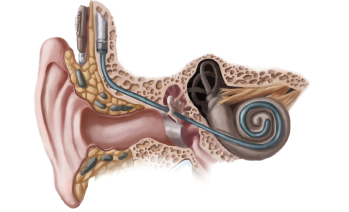What do we know about intracochlear fibrosis and the foreign body response (FBR) following cochlear implantation (CI)?
BOTTOM LINE: Intracochlear fibrosis following CI represents a significant limiting factor for the success of CI users. Several strategies have been employed to mitigate FBR within the cochlea, including drug delivery systems and modifications in surgical technique and electrode design.
Explore This Issue
January 2020BACKGROUND: While CIs are generally considered biocompatible, an inflammatory/fibrotic response occurs after electrode array implantation involving formation of a densely organized fibrous sheath surrounding the electrode track that can expand to include loose areolar fibrotic tissue, granulomas, or new bone formation (neo-ossification). This FBR could be a significant limiting factor to CI success and outcomes.
 STUDY DESIGN: Literature search and review of 90 peer-reviewed articles describing the FBR or intracochlear fibrosis following CI.
STUDY DESIGN: Literature search and review of 90 peer-reviewed articles describing the FBR or intracochlear fibrosis following CI.
SETTING: PubMed database.
SYNOPSIS: In the presence of a foreign body, fibroblast proliferation and extracellular matrix deposition becomes dysregulated, resulting in an irreversible fibrotic response; FBR can also lead to CI biomaterial degradation. This fibro-osseous reaction could be a contributing factor to delayed loss of residual acoustic hearing after hearing preservation CI, and the cause remains largely unknown. Intracochlear fibrosis is theorized to modify vibrations of the basilar membrane apically, which may impact native low-frequency hearing. Electrode insertion through a cochleostomy may lead to endosteal damage to the scala vestibuli and resultant intracochlear fibrosis. Fibrosis within the cochlea is associated with elevated electrical impedances, requiring higher voltages that lead to decreased dynamic stimulation range and CI battery life. Neo-ossification could also decrease the efficacy of future surgeries and may limit future therapies aimed at hair cell or neuron regeneration. Several strategies to mitigate the inflammatory/fibrotic response following CI, including pharmacological (immune/inflammatory modulating drugs, anti-apoptotic compounds, antioxidants) and surgical modifications (“soft” electrode insertion techniques, choice of surgical entry), development of new electrode arrays, and modifications to CI biomaterials themselves, have been proposed.
CITATION: Foggia MJ, Quevedo RV, Hansen MR. Intracochlear fibrosis and the foreign body response to cochlear implant biomaterials [published online ahead of print November 13, 2019]. Laryngoscope Investig Otolaryngol; doi.org: 10.1002/lio2.329.